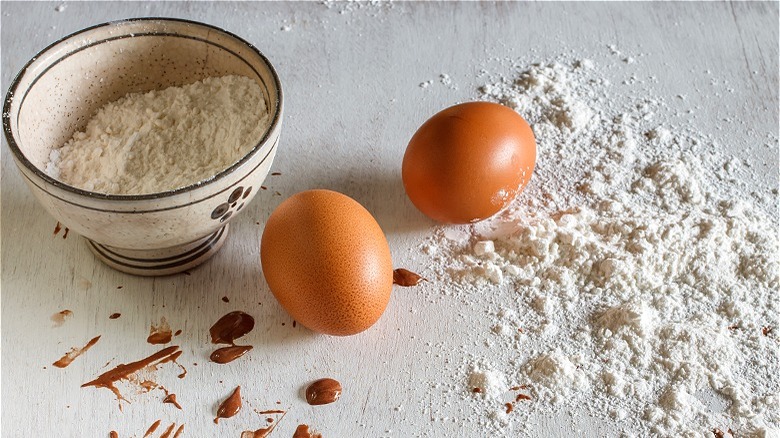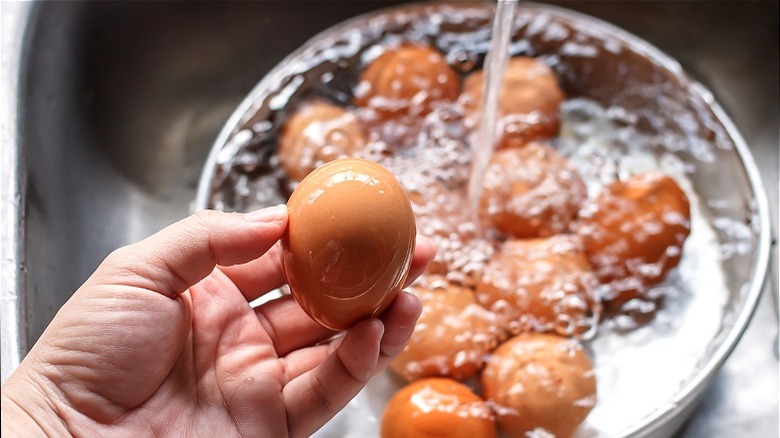Room Temperature Eggs Are The Key To The Fluffiest Cake Possible
When you go through the trouble of making a homemade dessert like your favorite sheet pan vanilla cake, you want to feel like your efforts were well spent when you take that first long-awaited bite. Cakes can be especially finicky when it comes to incorporating wet and dry ingredients, and finding that sweet spot in terms of the ideal baking time. Who enjoys a dry piece of cake anyway?
Of all the steps to consider in the cake-making process though, one factor that you may often overlook due to time constraints is the use of room temperature eggs. If your favorite cake recipe calls for soft butter, this is hard to skip since butter will go flying if you try adding a cold stick into a stand mixer. Yet, room temperature eggs may often be discounted since they're generally runny even in colder temperatures.
However, when room temperature eggs are added to other wet ingredients and vigorously mixed, air gets trapped inside your precious cake batter and expands during baking. Room temperature eggs are also easier to whip (think of how hard it can be to whisk cold eggs straight from the fridge for an omelet — they don't become homogenous so easily). Cold eggs also don't mix nicely with butter, they'll actually make your butter colder — even room-temp butter. Room temperature eggs blend beautifully with soft butter and create a lump-free, airy batter.
How to know when eggs reach room temperature
According to a trial conducted by America's Test Kitchen, where both cold and room temperature eggs were used in a basic cake recipe, the cake made with tepid eggs proved easier to mix, baked faster, and had both a lighter and softer crumb. However, there may be a good reason why you might be tempted to leave eggs in cold storage until use. According to the USDA, raw eggs should be kept refrigerated and not left out at room temperature for more than 2 hours due to potential bacterial growth.
If you have a hard time remembering all the steps when it comes to making a homemade cake, you may be cautious about leaving your eggs out for a few hours on the off-chance you accidentally leave them out too long. But if you do think preemptively and take your eggs out ahead of time, how can you actually tell if they've sufficiently reached room temperature?
A room temperature egg falls between 68 and 70 degrees Fahrenheit. You can crack eggs in a bowl and take their temperature with an instant-read thermometer, or you can feel the outside shell to determine if the hard outer layer still feels cool to the touch. If that feels like too much guesswork — or if you're in a hurry — there are a few simple ways you can bring your cold eggs to room temperature in a flash.
Bringing eggs to room temperature without planning ahead
Believe it or not, the quickest method for getting eggs to room temperature varies depending on how fast you need eggs for your next cake. If you have at least an hour to spare, you can place cold eggs in a bowl of warm water until the eggs' outer shells no longer feel cold. This can take up to an hour since soaking eggs in hot water isn't recommended. If you need a faster method, any amount of time your eggs can soak in warm water is better than none. Therefore, soak them as long as you're able, but aim for at least ten minutes.
Alternatively, you can also place your eggs in a bowl under your kitchen faucet and allow warm water to run over them for up to ten minutes. With room temperature eggs, you're sure to taste the difference in your resulting cake. The next time a homemade cake is on the menu, not only should you be careful when measuring your ingredients, but make sure your curated ingredient list includes room temperature eggs, leaving you one step closer to a fluffier cake.


